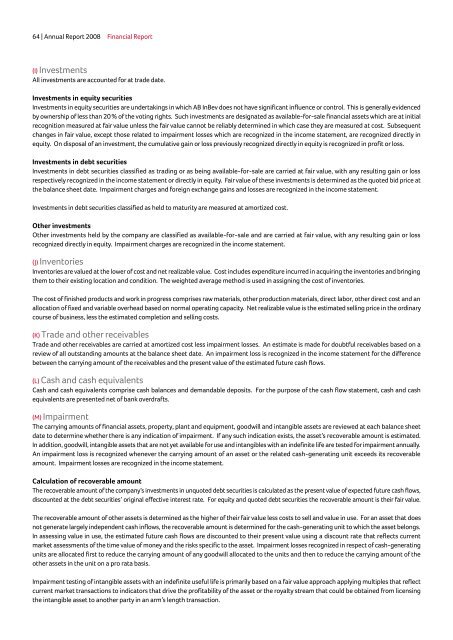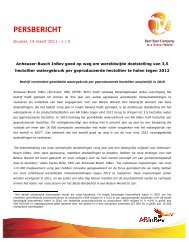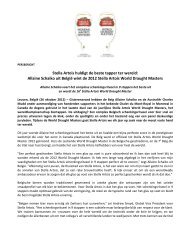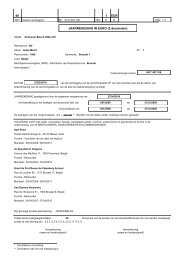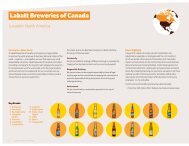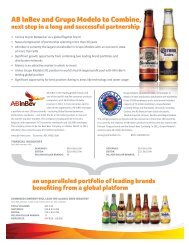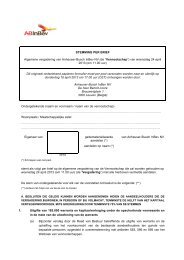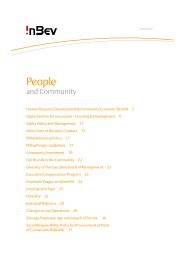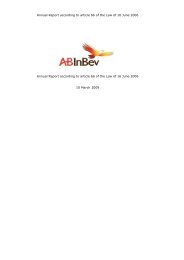The Best Beer Company in a Better World - Anheuser-Busch InBev
The Best Beer Company in a Better World - Anheuser-Busch InBev
The Best Beer Company in a Better World - Anheuser-Busch InBev
Create successful ePaper yourself
Turn your PDF publications into a flip-book with our unique Google optimized e-Paper software.
64 | Annual Report 2008 F<strong>in</strong>ancial Report<br />
(I) Investments<br />
All <strong>in</strong>vestments are accounted for at trade date.<br />
Investments <strong>in</strong> equity securities<br />
Investments <strong>in</strong> equity securities are undertak<strong>in</strong>gs <strong>in</strong> which AB <strong>InBev</strong> does not have significant <strong>in</strong>fluence or control. This is generally evidenced<br />
by ownership of less than 20 % of the vot<strong>in</strong>g rights. Such <strong>in</strong>vestments are designated as available-for-sale f<strong>in</strong>ancial assets which are at <strong>in</strong>itial<br />
recognition measured at fair value unless the fair value cannot be reliably determ<strong>in</strong>ed <strong>in</strong> which case they are measured at cost. Subsequent<br />
changes <strong>in</strong> fair value, except those related to impairment losses which are recognized <strong>in</strong> the <strong>in</strong>come statement, are recognized directly <strong>in</strong><br />
equity. On disposal of an <strong>in</strong>vestment, the cumulative ga<strong>in</strong> or loss previously recognized directly <strong>in</strong> equity is recognized <strong>in</strong> profit or loss.<br />
Investments <strong>in</strong> debt securities<br />
Investments <strong>in</strong> debt securities classified as trad<strong>in</strong>g or as be<strong>in</strong>g available-for-sale are carried at fair value, with any result<strong>in</strong>g ga<strong>in</strong> or loss<br />
respectively recognized <strong>in</strong> the <strong>in</strong>come statement or directly <strong>in</strong> equity. Fair value of these <strong>in</strong>vestments is determ<strong>in</strong>ed as the quoted bid price at<br />
the balance sheet date. Impairment charges and foreign exchange ga<strong>in</strong>s and losses are recognized <strong>in</strong> the <strong>in</strong>come statement.<br />
Investments <strong>in</strong> debt securities classified as held to maturity are measured at amortized cost.<br />
Other <strong>in</strong>vestments<br />
Other <strong>in</strong>vestments held by the company are classified as available-for-sale and are carried at fair value, with any result<strong>in</strong>g ga<strong>in</strong> or loss<br />
recognized directly <strong>in</strong> equity. Impairment charges are recognized <strong>in</strong> the <strong>in</strong>come statement.<br />
(J) Inventories<br />
Inventories are valued at the lower of cost and net realizable value. Cost <strong>in</strong>cludes expenditure <strong>in</strong>curred <strong>in</strong> acquir<strong>in</strong>g the <strong>in</strong>ventories and br<strong>in</strong>g<strong>in</strong>g<br />
them to their exist<strong>in</strong>g location and condition. <strong>The</strong> weighted average method is used <strong>in</strong> assign<strong>in</strong>g the cost of <strong>in</strong>ventories.<br />
<strong>The</strong> cost of f<strong>in</strong>ished products and work <strong>in</strong> progress comprises raw materials, other production materials, direct labor, other direct cost and an<br />
allocation of fixed and variable overhead based on normal operat<strong>in</strong>g capacity. Net realizable value is the estimated sell<strong>in</strong>g price <strong>in</strong> the ord<strong>in</strong>ary<br />
course of bus<strong>in</strong>ess, less the estimated completion and sell<strong>in</strong>g costs.<br />
(K) Trade and other receivables<br />
Trade and other receivables are carried at amortized cost less impairment losses. An estimate is made for doubtful receivables based on a<br />
review of all outstand<strong>in</strong>g amounts at the balance sheet date. An impairment loss is recognized <strong>in</strong> the <strong>in</strong>come statement for the difference<br />
between the carry<strong>in</strong>g amount of the receivables and the present value of the estimated future cash flows.<br />
(L) Cash and cash equivalents<br />
Cash and cash equivalents comprise cash balances and demandable deposits. For the purpose of the cash flow statement, cash and cash<br />
equivalents are presented net of bank overdrafts.<br />
(M) Impairment<br />
<strong>The</strong> carry<strong>in</strong>g amounts of f<strong>in</strong>ancial assets, property, plant and equipment, goodwill and <strong>in</strong>tangible assets are reviewed at each balance sheet<br />
date to determ<strong>in</strong>e whether there is any <strong>in</strong>dication of impairment. If any such <strong>in</strong>dication exists, the asset’s recoverable amount is estimated.<br />
In addition, goodwill, <strong>in</strong>tangible assets that are not yet available for use and <strong>in</strong>tangibles with an <strong>in</strong>def<strong>in</strong>ite life are tested for impairment annually.<br />
An impairment loss is recognized whenever the carry<strong>in</strong>g amount of an asset or the related cash-generat<strong>in</strong>g unit exceeds its recoverable<br />
amount. Impairment losses are recognized <strong>in</strong> the <strong>in</strong>come statement.<br />
Calculation of recoverable amount<br />
<strong>The</strong> recoverable amount of the company’s <strong>in</strong>vestments <strong>in</strong> unquoted debt securities is calculated as the present value of expected future cash flows,<br />
discounted at the debt securities’ orig<strong>in</strong>al effective <strong>in</strong>terest rate. For equity and quoted debt securities the recoverable amount is their fair value.<br />
<strong>The</strong> recoverable amount of other assets is determ<strong>in</strong>ed as the higher of their fair value less costs to sell and value <strong>in</strong> use. For an asset that does<br />
not generate largely <strong>in</strong>dependent cash <strong>in</strong>flows, the recoverable amount is determ<strong>in</strong>ed for the cash-generat<strong>in</strong>g unit to which the asset belongs.<br />
In assess<strong>in</strong>g value <strong>in</strong> use, the estimated future cash flows are discounted to their present value us<strong>in</strong>g a discount rate that reflects current<br />
market assessments of the time value of money and the risks specific to the asset. Impairment losses recognized <strong>in</strong> respect of cash-generat<strong>in</strong>g<br />
units are allocated first to reduce the carry<strong>in</strong>g amount of any goodwill allocated to the units and then to reduce the carry<strong>in</strong>g amount of the<br />
other assets <strong>in</strong> the unit on a pro rata basis.<br />
Impairment test<strong>in</strong>g of <strong>in</strong>tangible assets with an <strong>in</strong>def<strong>in</strong>ite useful life is primarily based on a fair value approach apply<strong>in</strong>g multiples that reflect<br />
current market transactions to <strong>in</strong>dicators that drive the profitability of the asset or the royalty stream that could be obta<strong>in</strong>ed from licens<strong>in</strong>g<br />
the <strong>in</strong>tangible asset to another party <strong>in</strong> an arm’s length transaction.


